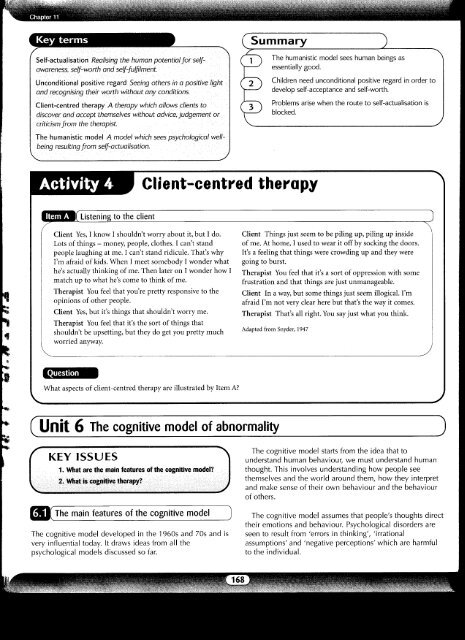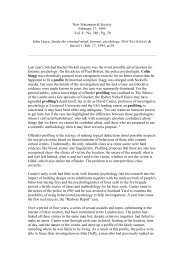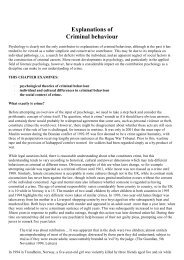Ch 11 - Jeff Standen
Ch 11 - Jeff Standen
Ch 11 - Jeff Standen
Create successful ePaper yourself
Turn your PDF publications into a flip-book with our unique Google optimized e-Paper software.
Key terms<br />
Self-actualisation Realising the human potential for selfawareness,<br />
self-worth and self-fulfilment.<br />
Unconditional positive regard Seeing others in a positive light<br />
and recognising their worth without any conditions.<br />
Client-centred therapy A therapy which allows clients to<br />
discover and accept themselves without advice, judgement or<br />
criticism from the therapist.<br />
( Summary 1<br />
The humanistic model sees human beings as<br />
essentially good.<br />
<strong>Ch</strong>ildren need unconditional positive regard in order to<br />
develop self-acceptance and self-worth.<br />
Problems arise when the route to self-actualisation is<br />
blocked.<br />
The humanistic model A model which sees psychological<br />
wellbeing<br />
resulting from<br />
self-actualisation.<br />
Activity 4<br />
Client-centred therapy<br />
Item A |( Listening to the client<br />
Client Yes, I know I shouldn't worry about it, but I do.<br />
Lots of things - money, people, clothes. I can't stand<br />
people laughing at me. I can't stand ridicule. That's why<br />
I'm afraid of kids. When I meet somebody I wonder what<br />
he's actually thinking of me. Then later on I wonder how I<br />
match up to what he's come to think of me.<br />
Therapist You feel that you're pretty responsive to the<br />
opinions of other people.<br />
Client Yes, but it's things that shouldn't worry me.<br />
Therapist You feel that it's the sort of things that<br />
shouldn't be upsetting, but they do get you pretty much<br />
worried anyway.<br />
Client Things just seem to be piling up, piling up inside<br />
of me. At home, I used to wear it off by socking the doors.<br />
It's a feeling that things were crowding up and they were<br />
going to burst.<br />
Therapist You feel that it's a sort of oppression with some<br />
frustration and that things are just unmanageable.<br />
Client In a way, but some things just seem illogical. I'm<br />
afraid I'm not very clear here but that's the way it comes.<br />
Therapist That's all right. You say just what you think.<br />
Adapted from Snyder, 1947<br />
What aspects of client-centred therapy are illustrated by Item A?<br />
( Unit 6 The cognitive model of abnormality<br />
J<br />
KEY ISSUES<br />
1. What are the main features of the cognitive model?<br />
2. What is cognitive therapy?<br />
|[ The main features of the cognitive model<br />
The cognitive model developed in the 1960s and 70s and is<br />
very influential today. It draws ideas from all the<br />
psychological models discussed so far.<br />
The cognitive model starts from the idea that to<br />
understand human behaviour, we must understand human<br />
thought. This involves understanding how people see<br />
themselves and the world around them, how they interpret<br />
and make sense of their own behaviour and the behaviour<br />
of others.<br />
The cognitive model assumes that people's thoughts direct<br />
their emotions and behaviour. Psychological disorders are<br />
seen to result from 'errors in thinking', 'irrational<br />
assumptions' and 'negative perceptions' which are harmful<br />
to the individual.







